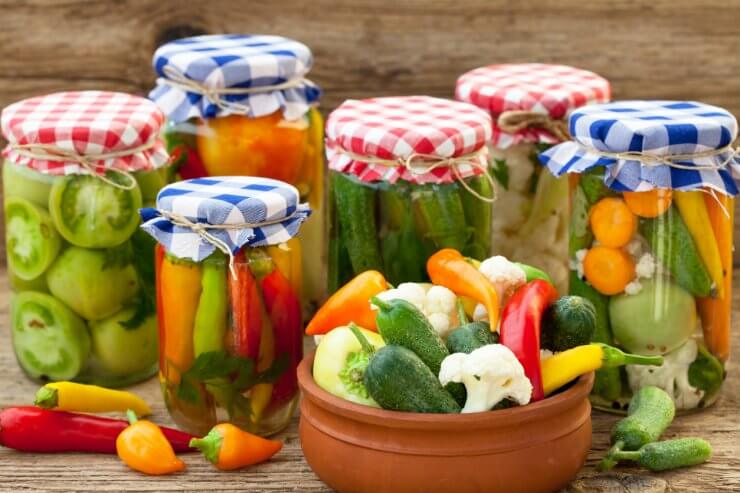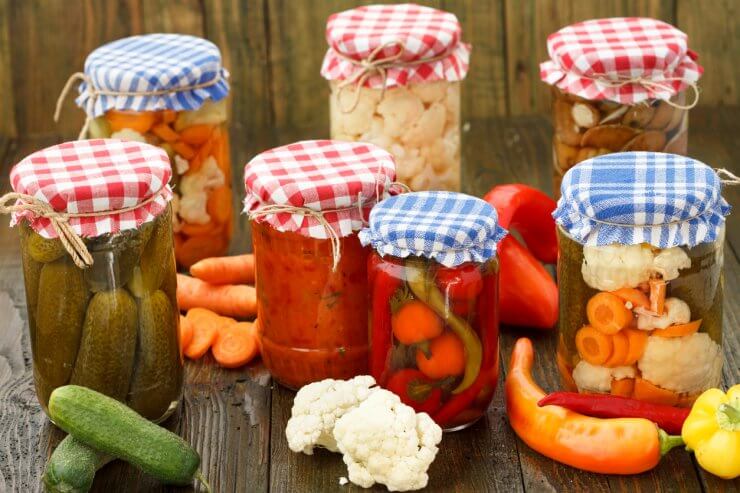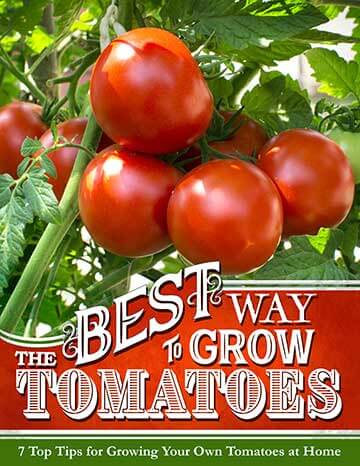
There’s something special about growing pounds and pounds of your favorite vegetables. It makes every meal feel like a celebration when you have heirloom tomatoes, fresh basil, crunchy cucumbers, and sweet peppers on your plate. As much as I love to cook, however, there are only so many veggies I can eat or share before they go bad. Enter… canning. Now, what are the best vegetables for canning and preserving?
Good question. Some vegetables, like onions and winter squash, can remain good for quite some time if you cure them and leave them alone in cool storage. Some, like peas, will do just fine if you freeze them. But if you really want to get your homesteading groove on, canning (or preserving) is the way to go. Plus, grabbing your own garden vegetables from the cupboard in the middle of winter is so rewarding.
Discover 7 top tips for growing, harvesting, and enjoying tomatoes from your home garden—when you access the FREE guide The Best Way to Grow Tomatoes, right now!

Safety first! When in doubt, throw it out!
Before we go any further, I have to mention food safety issues. It is so, so easy to introduce contaminants into food when you’re canning. Yeah, it’s a bummer to pull out a jar of your favorite veggie, only to find it covered in mold. But it’s really a bummer when invisible, harmful bacteria are living and reproducing in your canned vegetables. Botulism is no joke.
The Centers for Disease Control and Prevention have an entire section on this on their website, but here’s the short version:
“Never taste food to determine if it is safe. Do not taste or eat food that is discolored, moldy, or smells bad. Do not taste or eat food from cans that are leaking; have bulges or are swollen; or look damaged, cracked, or abnormal. Do not taste or eat food from a can that spurted liquid or foam when it was opened.”
The USDA also has an extensive “Complete Guide to Home Canning” covering everything from tomatoes to vegetables to fruits and even meats and seafood. There is a lot of information in the guide that’s well worth looking through if you’re thinking about canning.
That said, people have been canning and preserving foods for generations, so be cautious, be careful, but don’t be afraid of it. It’s a great way to save on food costs, keep high-quality vegetables on hand, and, well, it’s just cool.
The best vegetables for canning, preserving and eating any time you want
Okay, so what are the best vegetables for canning? Tomatoes are an obvious winner here. They don’t have a long shelf-life, and when you have a billion pounds of tomatoes that come in all at once, you have to do something with them! You can use them as they are, or make juice, sauce, salsa, or ketchup and can them that way.
Here are ten more of the best vegetables for canning and preserving (in alphabetical order because that seems easiest).
- Asparagus. Wash and trim your asparagus. Can it in pieces or in spears.
- Beets. Trim the tops and leaving some stem and roots. Boil to remove the skins. Can beets whole or cut in half or quarters for larger beets.
- Carrots. Wash ’em, peel ’em, slice ’em or dice ’em.
- Corn. Cut the kernels from the cob, making sure not to scrape the cob.
- Cucumbers. Cucumbers are among the classic best vegetables for canning. Use them as they are or make pickles!
- Green beans. Another classic. You can leave them raw to can them. Clip off the ends and can them as they are, or cut them into one-inch pieces.
- Okra. Wash the pods, trim the ends, and leave whole or cut into one-inch pieces.
- Peaches. I know. This is supposed to be about the best vegetables for canning, not the best fruits for canning. But in-season peaches are one of the best things in life, as far as I’m concerned, so why not preserve them?
- Peppers. Blister or boil peppers so you can remove the skins. Leave small peppers whole and cut large ones in half.
- Tomatoes. Yes, I know I already mentioned this, but it’s worth bringing up again. Out-of-season, supermarket tomatoes just aren’t the same as homegrown tomatoes. Sure, supermarket tomatoes are fine if you need them for a mid-winter stew or other recipe. But if you can preserve that late-summer bounty from your own garden, go for it!
Tools for canning safely
Food Thermometer
Safety first! Before you begin using your canning supplies, be sure to read carefully about the canning method you’ve chosen. Variables like temperature, seal, and timing make all the difference in keeping your preserved foods from growing dangerous bacteria or botulism toxins. Using a food thermometer is essential for canning and storing safely.
Top Food/ Candy Thermometers on Amazon:
- KT THERMO Candy/Deep Fry Thermometer
- Polder Candy/Jelly/Deep Fry Thermometer Stainless Steel with Pot Clip
- ThermoPro TP510 Waterproof Digital Candy Thermometer with Pot Clip
Wide Mouth Canning Jars (and Lids)
When canning tomato sauce, I prefer a larger wide-mouth jar since it’s easier to fill and holds more sauce. Another thing I like about the wider mouth jars is that they stack easier in my pantry. Be careful when stacking so as not to disturb the vacuum seal, though!
Top Wide Mouth Canning Jars on Amazon:
- Ball Wide Mouth Quart Jar Set of 12, 32 Ounce
- Ball 16 Oz. Wide Mouth Pint 12 Pieces Jars
- Ball Wide Mouth Half Gallon 64 Oz Jars
Organic Bottled Lemon Juice, or Powdered Citric Acid
Depending on your recipe, bottled lemon juice may be called for as an additive to increase the acidity and make your method of canning safer. The acidity also helps preserve your sauce longer. I prefer using organic bottled lemon juice as part of my tomato canning supplies because it doesn’t have additional preservatives and chemicals. Sometimes lemon juice adds too much liquid to a recipe. Powdered Citric Acid is a great substitute since it won’t add to your liquid volume and will accomplish the same acid boost as lemon juice, keeping your tomato sauce safer and fresher for longer. You can get lemon juice anywhere, but you can buy powdered citric acid on Amazon
Canning/Pickling Salt
Morton’s Canning and Pickling Salt is my go-to and a must-have in my canning supplies. It doesn’t contain iodine and extra minerals which sometimes affect the taste of canned sauces. It’s also free of anti-caking chemicals found in regular table salt. Those chemicals can affect the taste and color of canned vegetables, too, which is why this type of salt exists!
Pressure Canner
Some people use their plug-in pressure cookers and water baths for canning, but not everything can be safely be preserved that way. For example, tomatoes are a borderline low/high-acid food that makes it harder to preserve safely. And when it comes to food safety, I don’t mess around. If you’re making tomato sauce, the only device that gets hot enough to truly kill all bacteria, and especially if you’re making a meat sauce, is a stovetop pressure canner like a Presto 23-Quart Induction Compatible Pressure Canner, which is what I use.
Canning is a fun way to make your garden last longer. Plus, there are a lot of other fruits and vegetables you can use. I can guarantee when you open up a can of your garden veggies on a frigid winter night, you’ll be happy you decided to do this.
What are your favorite vegetables for canning? I’d love to read about them in the comments.
Note: Food Gardening Network contains links to affiliate websites including Amazon and Rakuten Affiliate Network and we may receive a commission for any eligible purchases made by you through links on this page.
Discover 7 top tips for growing, harvesting, and enjoying tomatoes from your home garden—when you access the FREE guide The Best Way to Grow Tomatoes, right now!





Thanks for this fantastic guide on vegetables for canning and preserving! The information is incredibly useful for anyone looking to stock up on homegrown goodness. I’m particularly interested in trying out the tips for preserving some of these vegetables. Do you have any additional advice on canning techniques or storage tips to ensure the best quality and flavor? I’m eager to start preserving and would love to hear more about your favorite recipes or methods. Thanks again for sharing such valuable insights!
We have dozens of great articles on food preservation. Here’s a link to the list.
https://foodgardening.mequoda.com/category/daily/food-preservation/
Thank you for this comprehensive list! I’ve been trying to incorporate more seasonal vegetables into my diet, and this guide is just what I needed for summer. I’m particularly excited to try more zucchini and cucumbers in my meals, as they’re so refreshing in the heat. Do you have any recipe suggestions for these vegetables? I’d love to know more ways to enjoy them beyond just salads.
Please check out our premium guides on Cucumbers and Zucchini – each one has several recipes that feature these vegetables. Here’s a link to the complete list of guides.
https://foodgardening.mequoda.com/collections/
How can you can or preserve safely avocados I get lots of them but I don’t know how to keep them around for extended periods and would like know if you have any suggestion
I have seen people freeze dry smashed avocados, then just add water when they use it.
I’m wondering how to freeze dry vegetables. You tell us how to safely can with the pressure cooker, but no information on how to freeze dry. Please email me?
i have pickled carrots can i seal them in the oven so to keep them ferm
No, no, no…Never process in the oven. The purpose of water bath or pressure canning is to get the contents inside up to a temperature that will kill the bacteria. Your oven will not get hot enough. Please research safe canning through USDA.
please, can you tell me how to can vegetables?
There are five ways to preserve vegatables.
1. Pressure canned in a pressure canner. This produces heat hot enough to kill bacteria. The other four ways to preserve veggies is pickling, fermenting, dehydrating, and now freeze drying.
Do you have any suggestions for beginner living in apartment I love to start canning
Yes! I wrote an article on pressure canning safety, which is a great place to start. When I started canning, I didn’t realize that different foods and their acidity levels would determine how things would be preserved, and how you can’t just change a recipe you found online when it comes to some foods like tomato sauce or pickles, but especially meats and other things, because they might not be food-safe if you do. Here’s a bigger primer on that: https://foodgardening.mequoda.com/daily/pressure-canning-safety-rules-to-live-by/
Hello I have a lot of garden tomatoes and I want to can and stew them can you tell exactly what all goes in the jars? I also the green tomatoes in jars: can you give the ingredients for them thank you I don’t want to lose any